Ulan-Ude arose in 1666 as a winter residence which was built by Russian Cossacks. A little later a fortress was built at the confluence of the Uda River in Selenga — the river carrying its waters to Lake Baikal. Like other similar fortresses in Russia it defended its far fronts from the enemy raids. And in the XVII century a settlement Verkhneudinsk appeared instead of a fortress on the Uda River. In 1775 it received the status of a city. In 1934 Verkhneudinsk was renamed Ulan-Ude which means «Red Uda» in the Buryat language.
For a long time Ulan-Ude was a stronghold of Russian culture in the remote Siberian regions. Here government institutions and several Orthodox churches were concentrated. Handicraft shops appeared one after another and factories were built. The young city was forced to provide itself with everything necessary. Here bread was grown in uneasy climatic conditions, flour was grounded, soap was made and leather was processed. Later there was the famous Sunday Verkhneudinsk Fair — the engine of the local economy and the center of public life. The spontaneously organized market was so successful that soon shopping malls really appeared there. Now it is a historical landmark in the Revolution Square, but then hundreds of peasants and craftsmen from neighboring villages came to trade at the fair every Sunday.
Merchants were originally considered to be the aristocracy of Ulan-Ude. Prosperous and enterprising merchants influenced the shaping of the city and its development. After the Decembrist uprising in 1825 the exiled rebel nobility introduced modern culture and free-thinking into the city. So, schools, gymnasiums, home theaters and salons appeared here.
By the beginning of the twentieth century Ulan-Ude was a classical Siberian settlement with many handicraft shops and private factories. In 1917 the local population supported the October Revolution and Soviet power was established in the city. There were bloody battles with Мanchurian Cossack divisions and Japanese and American troops helping them. The city, which for its long history has never participated in large-scale battles, was forced to defend for two long years. When in 1920 the Red Army won the final victory, the townspeople wanted only one thing: peace and tranquility. Here the Far Eastern Republic (FER) was formed, one of the first democracies that existed on the territory of Soviet Russia. It was a strange formation for the Soviet era: with the capitalist economy, secular administration, its own currency, flag and coat of arms. The Far Eastern Republic became a «buffer» state between Japan and Soviet Russia. In 1922 the republic joined RSFSR ( Russian Soviet Federative Socialistic Republic).
About 450 thousand people live in Ulan-Ude at present. It is a quiet provincial city in which Soviet high-rise buildings coexist with old merchants’ mansions, and Buddhist datsans — with Orthodox churches. The Victory Day, the Christian Easter and the Buryat «White Month» holiday (Sagaalgan) are celebrated with equal respect in Ulan-Ude. The walking along the popular hiking route «Green Line» in the city center gives complacency and contemplation. Buddhism spread equally with Orthodoxy accustoms to tolerance. Russians, Evenki, Mongols, Buryats have lived here for a long time overcoming the difficulties of the local climate, and have become almost relatives.
But Buddhism occupies a special place in the culture of Ulan-Ude. One of the religious Buddhist shrines — the imperishable body of Lama Dashi-Dorzho Itigelov- is kept here in the Ivolginsky Datsan of Ulan-Ude. The springs with sacred water sprinkle in the vicinity of the city, and pilgrims and medical centers work at the temples. They treat here according to ancient recipes of ancestors: with a help of koumis, herbs and meditation. Here one can think about the eternal, learn Tantra and Buddhist philosophy and feel himself involved in the traditions of the East.In Ulan-Ude there are several interesting museums and a magnificent opera and ballet theater where classical performances are staged. One can see a giant monument in the form of Lenin’s head in the center of the city which is considered to be the largest in the world among such kind of monuments. This sculpture is a visiting card of Ulan-Ude, an absolutely unique monument worth seeing. Besides the Lenin’s head monument, tourists coming to the city are worried about the ways and routes leading to the unique and clean Lake Baikal. One of the most beautiful lakes in the world is just two hours drive away from the city, so Ulan-Ude is often called the tourist capital of the Lake Baikal. The bus route which takes 12 hours from Ulan-Ude to Ulan Bator, the capital of the neighboring exotic Mongolia, also causes interest. Such a trip can become an additional highlight in the journey through the Russian Siberia.
However, there is no need to escape from the city. At any time of year any person can find an exciting affair after his own heart. In particular, one should take into account that there are a record number of authentic Buryat and Mongolian holidays here. In addition to the above mentioned Sagaalgan, after which the government of the republic announces a national holiday every winter, here they also celebrate Surkharban (this word in Buryatian means an arrow that hits the target). In early July horseraces and traditional Mongolian competition in «sur» (leather balls stuffed with wool) shooting begins. In September the romantic holiday Zula-Khural is celebrated, «the festival of a thousand candles». If one visits Ulan-Ude in September, he can get the large-scale festivities in honor of the City Day as well as the merry Baikal Day. The New Year is celebrated several times here — both Russian and Chinese, and they even celebrate New Year according to the Hunnish calendar in October!
Legends go about plentiful and hospitable Buryat feasts. All, who are fortunate enough to taste local pastries, say that they have never tasted anything more delicious than the wheat bread baked in Ulan-Ude. Local cuisine is hearty and tasty. Its three main ingredients are meat, milk and fish. Buryats drink tea mainly with milk and butter. Fans of classic tea drinking will be very interested in getting acquainted with this way of tea brewing! Once in the city, one needs to taste crispy dried milk scum and wheat-flour tortilla with sour cream.
The most famous fish dishes are the ones that are made from Baikal omul. As for the meat dishes, one cannot miss pozy, one of the few Buryat delicacies known far beyond the borders of the republic. In fact, these are large dumplings with minced meat and broth inside. It is worth also tasting hirmasa — thick soup with meat, giblets and homemade noodles, as well as khushuur — delicious fried pies with meat. Buryat stew bukhuler with potatoes, onions and lamb is also popular: its recipe is very simple, but it is delicious! The traditional Buryat drink is koumis — freshly fermented mare milk. One drinks it to quench his thirst, to saturate the body with useful vitamins and minerals and to get rid of many diseases. Treating with koumis was very popular here in ancient times, and local healers always included this drink in the list of their miraculous means.
When going to Ulan-Ude, it is important to remember that locals are very calm and unhurried people, and you will be surprised with the harsh simplicity of the nature of Transbaikal. Around the city there are many interesting routes for trekking, ski walks and other sports entertainment. For example, the «Path of Health», which begins with the ethnographic museum, is very interesting. There are no large enterprises in Ulan-Ude, therefore the air is very clean here. To this should be added a large number of sunny days — 10 months a year, as the city is located on a flat high plateau. The dry continental climate makes it possible to endure serious Siberian frosts quite easily. So, nature and unusual local attractions and colorful food will certainly leave incomparable impressions in your memory!
Get directions
The most convenient way of getting to Ulan-Ude is by air. The city has an airport «Baikal», serving regular flights of airlines «Ural Airlines» and «S7» from Moscow and St. Petersburg. The flight time is 5-6 hours. There is also an international air service: with Beijing (China), Ulan Bator (Mongolia) and Pyongyang (North Korea). It is also possible to go to Ulan-Ude by train. The railway connects the city with Vladivostok, Chita, Blagoveshchensk, Novosibirsk, Severobaikalsk and other cities of Siberia and the Far East. Trains often go to Moscow.
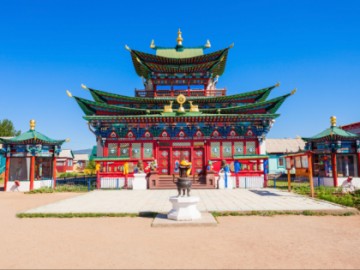

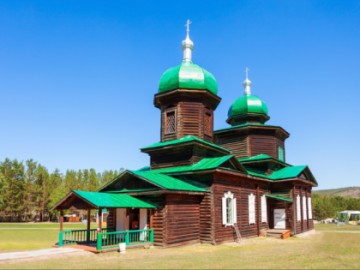

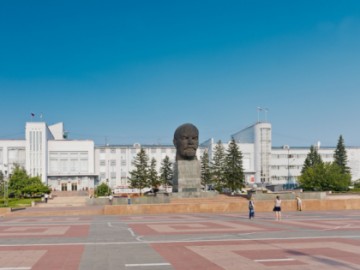

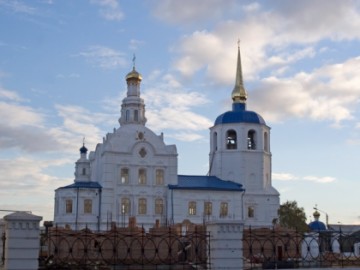

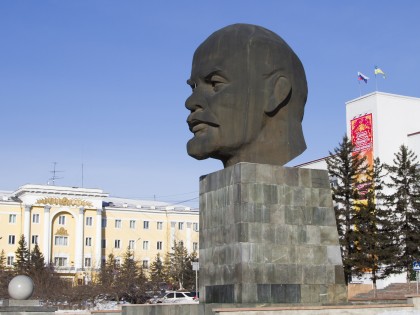
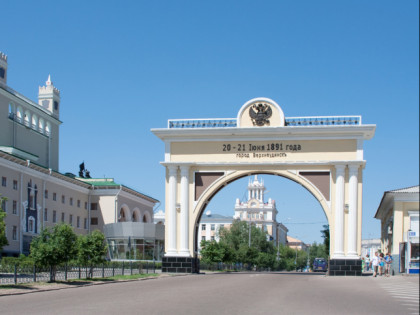
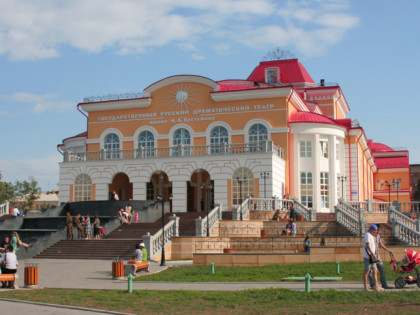
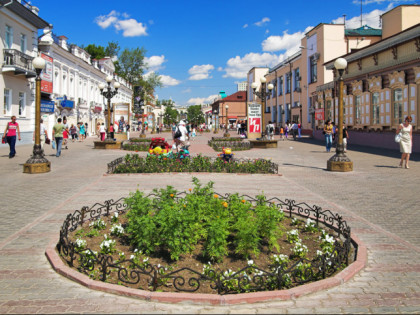
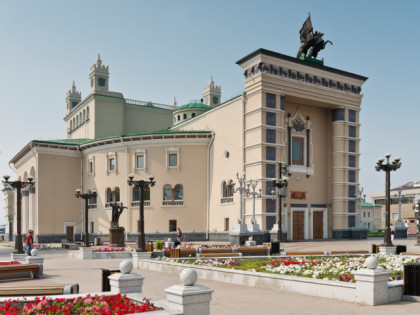
 Museums and Exhibitions
Museums and Exhibitions
 Other places
Other places
 Architectural Monuments
Architectural Monuments
 Temples and places of worship
Temples and places of worship